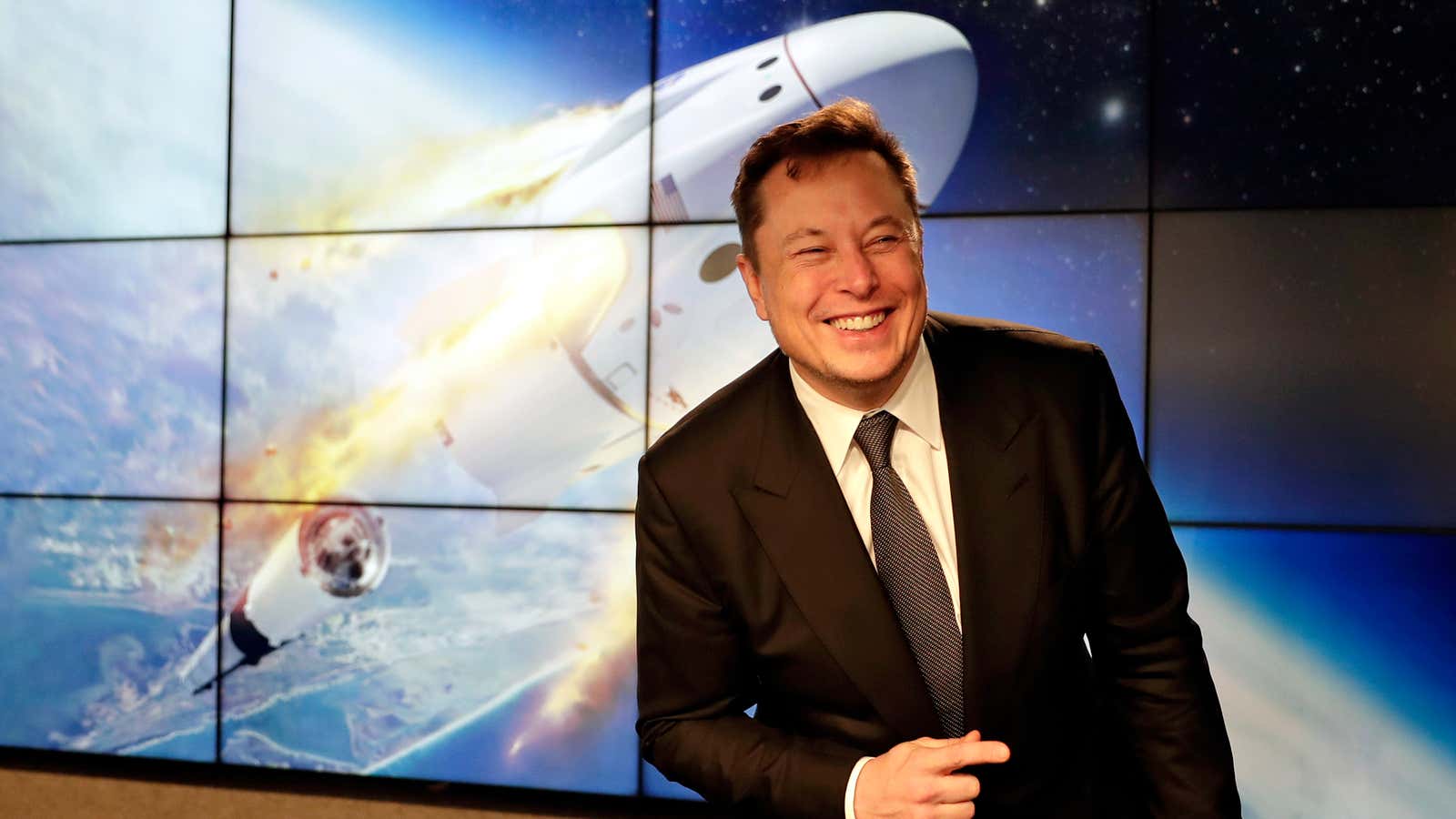Up to four passengers will be able to hire SpaceX’s Dragon spacecraft for a joyride around the Earth, Elon Musk’s company said today.
The experience will be brokered by SpaceAdventures, a US tourism firm that helped eight wealthy enthusiasts visit the International Space Station between 2001 and 2009.
The cost of the experience is not disclosed and likely negotiable. A SpaceAdventures spokesperson says the price would be “in the range as other orbital spaceflight opportunities.” The last individual orbital tourism flight, in 2009 by Cirque du Soleil founder Guy Laliberte, reportedly cost $30 million.
The experience will require a few weeks of training before a launch from the same pad at Kennedy Space Center where the Apollo rockets departed for the moon.
The space capsule will then orbit the Earth for an undisclosed period of time. Passengers will experience free-fall in microgravity and break the record for the highest altitude reached by spaceflight tourists. The current mark is the station itself, which circles about 254 miles (409 km) above the planet.
SpaceX officials did not respond to an interview request, and neither company said when the flight would take place. SpaceX adviser and former astronaut Garett Reisman said on twitter that planners are aiming for sometime in 2021.
SpaceX has been developing the Dragon spacecraft since 2011 as part of NASA’s commercial crew program to carry astronauts to the International Space Station. The Dragon completed its last major test in January. With a final crewed flight test expected as soon as May, the private firm is confident enough to begin advertising the vehicle for private use.
“SpaceX needs to fly people first,” SpaceAdventures president Tom Shelley told Quartz in 2016. “As much respect as everybody has for what they have achieved, they haven’t yet flown people…We’ll see what happens when they are successfully able to fly people.”
In 2019, NASA said it would allow private companies to begin shuttling paying passengers to the International Space Station. The space agency’s program to send its own astronauts to the ISS, however, has been delayed because of problems with Boeing’s contribution, a space capsule called Starliner. As a result, NASA will likely use the space available on private spacecraft to get its own personnel to the ISS first.
For tourists, skipping the station means simpler maneuvers and less risk, but limits the time they can spend in space. Previous SpaceAdventures passengers have spent more than a week in orbit, but the Dragon’s supply of oxygen and propellant will run out sooner.
The shorter trip will save passengers money: NASA says any visitors to the ISS will have to pay about $35,000 per day spent on the station. NASA officials suggested that the cost of flying to the ISS as a paying passenger would be around $58 million per person. It’s possible that the cost of the Dragon flight could be lower, however, due to a simplified mission and the reuse of a previously flown rocket booster and Dragon spacecraft.
This isn’t SpaceX’s first dalliance with tourism. The company has accepted an undisclosed payment from Japanese e-commerce billionaire Yusaku Maezawa to fly him and a handful of passengers around the moon in SpaceX’s still-in-development Starship rocket. Maezawa cast the trip as an art project before an abortive attempt to make a dating reality show out of the experience. It’s anyone’s guess when the rocket will be built and the trip will take place.
Still, space tourism is finally on the cusp of becoming available to the wealthiest adventurers. Shelley blames the lack of action since 2009 on a lack of vehicles, not a lack of interest. This year, publicly-traded Virgin Galactic is expected to begin regular suborbital space tourism flights—reaching altitudes of about 60 miles before returning to Earth after a few minutes—with tickets costing about a quarter million dollars. Blue Origin, Jeff Bezos’ space company, plans to fly its first crewed test flights this year in its suborbital rocket, the New Shepard, in preparation for a planned tourism business.
A trip to orbit, however, is a significantly bigger deal, in terms of engineering challenge, cost and experience itself.
“I would anticipate people taking a suborbital flight and becoming really inspired and wanting to go forward,” Shelley said in 2016. “A five minute wonderful ride and a beautiful view will be a great talking point and incredibly memorable, but there will be a select few who will go forward and experience what it is like to really live in space.”
